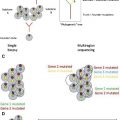Locally advanced non–small cell lung cancer is a heterogeneous disease with typically poor outcomes. Select patients may benefit from the integration of surgery, whereas patients with bulky, multistation, or contralateral (N3) mediastinal involvement are managed with definitive chemoradiation. Attempts to improve outcomes through induction, consolidation, or maintenance chemotherapy or radiation dose escalation have not demonstrated a survival benefit. Current research efforts focus on the integration of novel systemic agents that exploit tumor-specific driver mutations, augment antitumor immune response, or enhance radiation sensitivity.
Key points
- •
Stage III non–small cell lung cancer (NSCLC) is a heterogeneous disease.
- •
Concurrent chemoradiation with platinum/etoposide and carboplatin/paclitaxel is the standard of care for unresectable disease.
- •
60 Gy in standard fractionation remains the standard of care for radiation dose.
- •
Integration of novel immunotherapeutic and molecular targeted therapies is a promising area of investigation.
Introduction
Stage III NSCLC comprises the most heterogeneous group of patients and accounts for one-third of all patients diagnosed with lung cancer. Despite this heterogeneity, chemoradiation is the treatment of choice for the majority of patients. The 2-year and 5-year overall survival (OS) rates are estimated at 55% and 36%, respectively, for patients with stage IIIA disease and 34% and 19%, respectively, for patients with stage IIIB disease.
Stay updated, free articles. Join our Telegram channel

Full access? Get Clinical Tree




